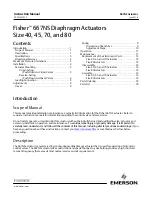
Instruction Manual
D102603X012
667NS Actuator
June 2018
10
bench set range (a) plus the friction force divided by the effective diaphragm area with increasing diaphragm pressure
or (b) minus the friction force divided by the effective diaphragm area with decreasing diaphragm pressure.
For an assembled valve‐actuator assembly, determine valve friction as described below:
1. Install a pressure gauge in the actuator loading pressure line that connects to the actuator diaphragm casing.
Note
Steps 2 and 4 require that you read and record the pressure shown on the pressure gauge.
2. Increase the actuator diaphragm pressure and read the diaphragm pressure as the actuator reaches its mid‐travel
position.
3. Increase the actuator diaphragm pressure until the actuator is at a travel position greater than its mid‐travel
position.
4. Decrease the actuator diaphragm pressure and read the diaphragm pressure as the actuator reaches its mid‐travel
position.
The difference between the two diaphragm pressure readings is the change in the diaphragm pressure required to
overcome the friction forces in the two directions of travel.
5. Calculate the actual friction force:
Friction
Force,
pounds
=1/2
Difference
in pressure
readings, psig
(
)
X
Effective
diaphragm area,
inches
2
(
)
Refer to table 1 and 5 for the effective diaphragm area.
When determining valve friction, you can make diaphragm pressure readings at a travel position other than mid‐travel
if you desire. If you take readings at the zero or at the full travel position, take extra care to ensure that the readings are
taken when the travel just begins or just stops at the position selected.
It is difficult to rotate the spring adjustor (key 74, figure 2, 3, or 4) when the full actuator loading pressure is applied to
the actuator. Release the actuator loading pressure before adjusting. Then re‐apply loading pressure to check the
adjustment.
Adjustment Steps
1. Monitor actuator loading pressure carefully when making adjustments. Do not exceed the maximum pressure
specifications of either the loading regulator or the actuator casings (refer to table 1 for maximum diaphragm
casing pressure).
2. Each actuator spring has a fixed pressure span. Changing the spring compression shifts the span up or down to
make valve travel coincide with the pressure range.
Note
Before turning the spring adjuster on size 70 or 80 actuators, assemble the stem connector around the actuator stem and the
anti‐rotating lug on the yoke. Mark the actuator stem as a visual reference to verify that stem rotation does not occur. Remove the
stem connector before rechecking the bench set.










































